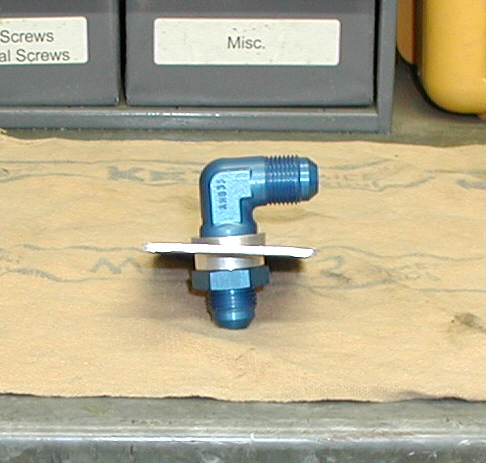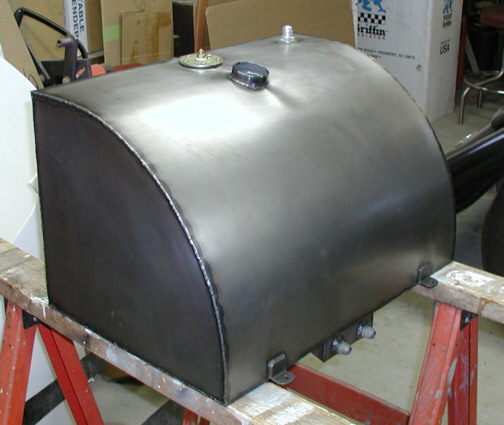What I did was make a tapered spacer
to go between the fitting and aluminum plate. By using a 1/4" thick
piece of aluminum with the same size hole as the plate (3/4"
diameter), I sanded an 1/8" off the one side to produce a taper. I
then cut off the excess and sand it round to fit like a washer.
|
|

|
I tried using only one tapered washer
but it wouldn't tighten down very well so I made a second one so the
fitting and nut would be parallel to each other. This worked great and
now the fitting sits at the correct angle.
|
|

|
This is the 4" longer line I had
to make. I had a LOT of trouble making this piece because it had to fit
just right. The first one I made was to short....along with the second
one. What I did was make one a little too long and trimmed it down a
small amount at a time till I had the correct length. I didn't have to
make any of the lines fit as close as this one did at any other time building the
car so this was a
challenge....to say the least. The reason it had to be just the right
length is because the tank and the fitting are close to one another and
they both bolt in place. This makes the length of the line critical and
If I never have to make one like this again, it will be too soon.
|
|

|
A look from the underside of the car
shows the finished plate with the fuel line connected. This plate cleans
up the hole very well and also keeps out any dirt that might find it's
way into the trunk.
|
|

|
At this point, the gas tank is finished and all that
awaits is to put fuel in it. I tested the tank with solvent to make
sure that it didn't leak because when filling it with water to do any
testing (like I did before), the water doesn't find ALL the holes like
solvent can. Solvent is thinner, like gas is so it's just a little
insurance against any leaks. Once I was satisfied that the tank was
leak-free, I rinsed it out with a little gas and then bolted it back in
place and put a couple of gallons of gas in it so I could start it. The
reason I wanted to start it was because it hadn't been run for a couple
of months so this gets things moving around which is a good thing. When
I turned the key, there wasn't even a click. I tried the dash lights and
again....nothing. I measured the amount of voltage in the battery and it
only had five volts. Well no wonder why nothing worked, the battery was
dead so out came the charger to give it new life again. I let it charge
over night and tried it again the next day and it had fire in the hole.
It sure is nice to here it run, even if it's only for a few minutes. Now I can get
busy on
my roll cage again which is one of the last things to do and the list is
getting very short at this point.
|
|

|
|
1 2
3 4
5 6
7 8
9 10
11 12
13 14 15
16 17
18 19
20 21 22 23
24 25
26 27
28 |
|
29
30
31 32
33 34
35 36
37 38 39 40
41 42
43 44
45 46
47 48
49 50
51 52 53 |
|
54
55
56 57
58 59
60 61
62 63
64 65
66 67
68 |